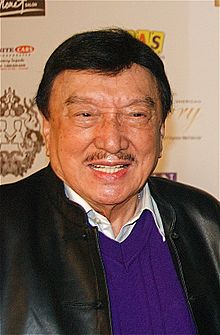- Comedy in the Philippines
-
 Dolphy, considered by Filipinos as King of Pinoy Comedy
Dolphy, considered by Filipinos as King of Pinoy Comedy
Majority of Filipinos, Comedy in the Philippines are considered as the best cinematography in the Filipino society. Contrast to American and European comedies, Pinoy Comedy is done by series of non-profane comedic languages (although they use words like tanga, sira ulo etc. they didn't use English profane words or the 7 dirty words) face shape, body type, and comedic sound effects(to excite people from the movies punches, fighting etc.). Pinoy Comedy started not by the Filipinos but by the Spanish colonist in the 16th century until 19th century by a series of theatric plays called Comedia. Comedy scripts in the colonial times are written in Spanish language (because the official language of that time is Spanish). Few Illustrados, a Filipino middle-class of the colonial period, work at theaters as actors and actresses and become comedians at the theater. They are considered as the first Filipino Comedians.
Comedy before Comedia
When Miguel Lopez de Legazpi and his men colonized the Philippines, a comedy theatre already exist. Well not necessarily a theatre but a ethnic ritual of dances and jokes. Ethnic Groups in the Philippines (such as the Ifugao, Ibaloi etc.) created these comedic dances but are being outlawed by the Spanish when they colonized the Philippines to prevent the rise of Revolts or anit-Spanish Propaganda.
Rakugo and the Philippines
Japanese and other Foreign kingdoms (or countries) went to the Philippines to trade their merchandises. Japanese merchants entertain Filipino buyers by doing comedy. This kind of entertainment is called Rakugo. Japanese Immigrants settled in what is now called the city of Paco, Manila and entertain Filipinos Rakugo and some Japanese teach Filipinos Rakugo until the Spanish replace local entertainment to European-style theaters.
Local comedy
Filipinos during the pre-colonial times created their own ritual comedy but these rituals did not survive longer because of the Spanish colonization in the Philippines. The only recorded Filipino ritual comedy is from Legazpi's sailor, "Roque", written in his diary. It is stated that Filipinos are proud from their ritual comedy.
Many of the Indians who watch the ritual, laugh so loud that they enjoy and love the ritual so much unlike our Aartieuropean counterpart of ritual. Maybe it's not a ritual, it's a comedy entertainment. Maybe the ancestors of these Indians already know comedy. I ask an Indian but he never understand me, so I went to visit an Indian scholar to know about their language. I study their language for just about ten months. I watch again from the ritual and I was very enjoyed. Their comedy is rare from our style of comedy where jesters went to the stage and make funny jokes about someone who is in the place. And there is strange part in this ritual where an Indian stands himself and tell jokes not about someone like teasing him or her but telling stories. These kind of ritual must be preserved for future generations to come.
— Roque
Roque is the first Spaniard to study the Tagalog Language but in the written names of Legazpi's crew, there are 5 sailors who have the name of Roque and 2 have the nickname of "Roque".
Categories:- Comedy and humor by nationality
- Philippine culture
Wikimedia Foundation. 2010.
